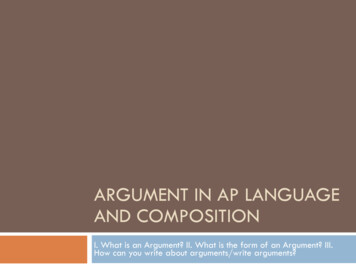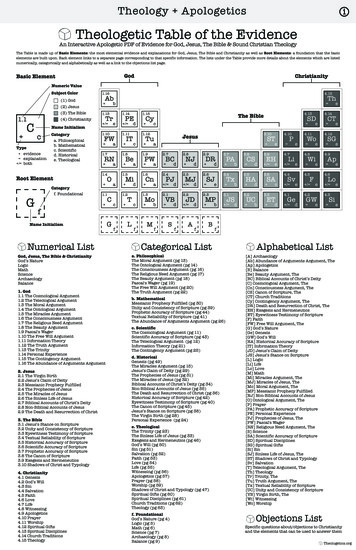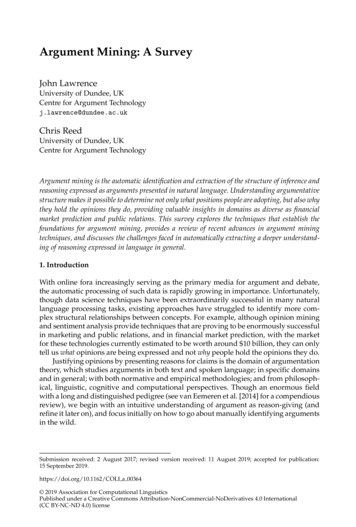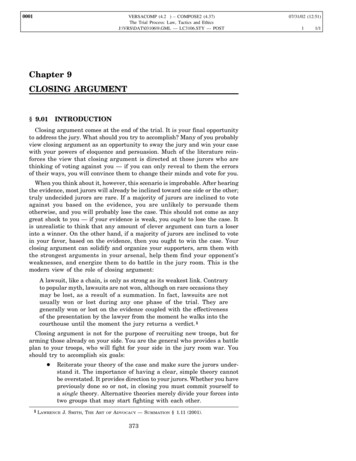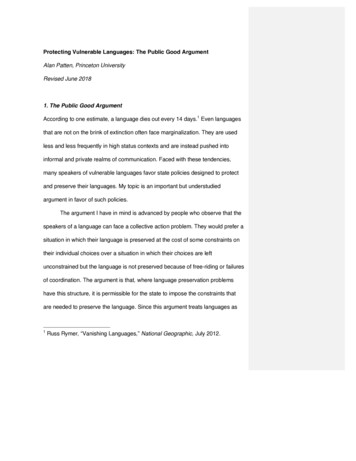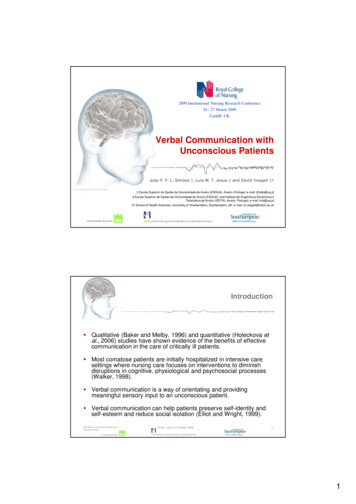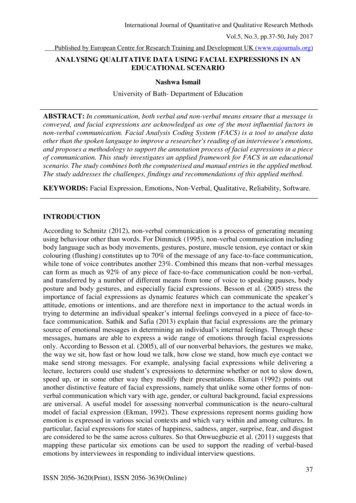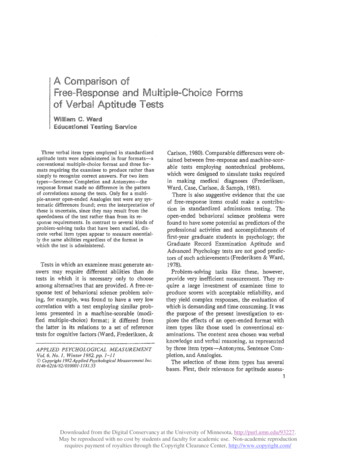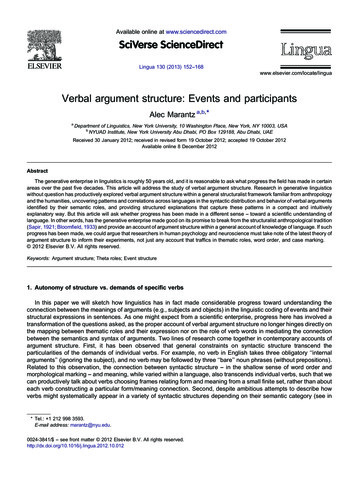
Transcription
Available online at www.sciencedirect.comLingua 130 (2013) 152--168www.elsevier.com/locate/linguaVerbal argument structure: Events and participantsAlec Marantz a,b,*aDepartment of Linguistics, New York University, 10 Washington Place, New York, NY 10003, USAbNYUAD Institute, New York University Abu Dhabi, PO Box 129188, Abu Dhabi, UAEReceived 30 January 2012; received in revised form 19 October 2012; accepted 19 October 2012Available online 8 December 2012AbstractThe generative enterprise in linguistics is roughly 50 years old, and it is reasonable to ask what progress the field has made in certainareas over the past five decades. This article will address the study of verbal argument structure. Research in generative linguisticswithout question has productively explored verbal argument structure within a general structuralist framework familiar from anthropologyand the humanities, uncovering patterns and correlations across languages in the syntactic distribution and behavior of verbal argumentsidentified by their semantic roles, and providing structured explanations that capture these patterns in a compact and intuitivelyexplanatory way. But this article will ask whether progress has been made in a different sense -- toward a scientific understanding oflanguage. In other words, has the generative enterprise made good on its promise to break from the structuralist anthropological tradition(Sapir, 1921; Bloomfield, 1933) and provide an account of argument structure within a general account of knowledge of language. If suchprogress has been made, we could argue that researchers in human psychology and neuroscience must take note of the latest theory ofargument structure to inform their experiments, not just any account that traffics in thematic roles, word order, and case marking. 2012 Elsevier B.V. All rights reserved.Keywords: Argument structure; Theta roles; Event structure1. Autonomy of structure vs. demands of specific verbsIn this paper we will sketch how linguistics has in fact made considerable progress toward understanding theconnection between the meanings of arguments (e.g., subjects and objects) in the linguistic coding of events and theirstructural expressions in sentences. As one might expect from a scientific enterprise, progress here has involved atransformation of the questions asked, as the proper account of verbal argument structure no longer hinges directly onthe mapping between thematic roles and their expression nor on the role of verb words in mediating the connectionbetween the semantics and syntax of arguments. Two lines of research come together in contemporary accounts ofargument structure. First, it has been observed that general constraints on syntactic structure transcend theparticularities of the demands of individual verbs. For example, no verb in English takes three obligatory ‘‘internalarguments’’ (ignoring the subject), and no verb may be followed by three ‘‘bare’’ noun phrases (without prepositions).Related to this observation, the connection between syntactic structure -- in the shallow sense of word order andmorphological marking -- and meaning, while varied within a language, also transcends individual verbs, such that wecan productively talk about verbs choosing frames relating form and meaning from a small finite set, rather than abouteach verb constructing a particular form/meaning connection. Second, despite ambitious attempts to describe howverbs might systematically appear in a variety of syntactic structures depending on their semantic category (see in* Tel.: 1 212 998 3593.E-mail address: marantz@nyu.edu.0024-3841/ -- see front matter 2012 Elsevier B.V. All rights 0.012
A. Marantz / Lingua 130 (2013) 152--168153particular Levin, 1993), the flexibility of verbs to appear within the various set of frames relating form and meaning hasdefied these efforts to regulate apparent alternations in argument structure through the classification of verbs. Thesetwo lines of research have shifted discussion away from verb classes and verb-centered argument structures to thedetailed analysis of the way that structure is used to convey meaning in languages, with verbs being integrated into thestructure/meaning relations by contributing semantic content, mainly associated with their roots, to subparts of astructured meaning representation.I will sketch below some of the new understanding of argument structure that we can attribute to this current line ofresearch. However, at the outset it is crucial to understand both the relationship between current research and pastproposals about argument structure and the basis for the claim that current research is not just part of a never-endingcycle of proposals that provide insight but no real closure. From the outset of generative grammar (undoubtedlyreflecting insights from previous work on language), two general ideas about argument structure (in the sense relevanthere) can be identified. On the one hand, we can point to Fillmore’s ‘‘Case for Case’’ (1967) as a landmark in thedevelopment of the idea that the mapping from verbal argument structure to syntax is mediated by the semantic roles ofarguments. On this view, a hierarchy of roles such as ‘‘agent’’ and ‘‘patient’’ form the basis of an explanation of thedistribution of phrases said to bear these roles in a linguistically described event. Work through the decades on thecontribution of a thematic hierarchy to the organization of arguments in syntax follow this tradition, along with researchinto the possibility of universal principles aligning thematic roles with grammatical relations or positions (as in theUniversal Alignment Hypothesis of Relational Grammar (see, e.g., Perlmutter, 1983), adopted by Baker (1988) as theUTAH or Uniformity of Theta Assignment Hypothesis). On the other hand, we can identify work in GenerativeSemantics (e.g., Postal, 1970) as key in the development of the idea that syntax is a reflection of a structuredrepresentation of meaning, with semantic predicate argument structures serving to yield syntactic hierarchicalstructure and syntactic asymmetries. On this view, relations between events (paraphrased in terms such as ‘‘cause’’and ‘‘become’’) anchor an explanation of the syntactic distribution of arguments, rather than the roles of the argumentsassociated with the events.1Contemporary linguists incorporate the insights of both these lines of research in their accounts of argumentstructure and structure/meaning correspondences. For example, current treatments of the external argument of averb phrase (often the agent) rely on insights from theta theory, which traces its history at least to Fillmore, while thesyntactic decomposition of event structure in current theories continues ways of thinking from Generative Semantics.We can claim progress from the proposals of the 1960s and 70s toward the goal of a theory of the knowledge oflanguage precisely because the goal has been consistent over the history of generative grammar, with a developingunderstanding of the requirements for descriptive and explanatory adequacy for a theory. That is, the progress to bedescribed below is progress from -- built on -- the discoveries of previous approaches, and new research on thesetopics should build on our present understanding. At the moment, our current best understanding of argumentstructure resembles the Generative Semantics view more than the ‘‘Case for Case’’ approach; this is because thesyntax has been shown to reflect relationships between events such as causation and change of state as much asthe relationship between entities and events described by thematic roles, and the relationship between entities andevents must be projected onto a basic structure reflecting the events and their relations. But the current theoryinvolves a radical reconception of the basic assumptions and principles of Generative Semantics. A linguist todaypushing a new theory more reliant on a mapping from theta roles to syntax would certainly need a reconceptualizationof theta roles designed to capture facts explained by the sort of event-structure decomposition of verb meanings to bedescribed below. In describing our current understanding of argument structure through the lens of current theory, wewill attempt to emphasize the deep generalizations captured by the current theory that will need to be ‘‘saved’’ in anyrevision of the theory aimed at answering currently open questions about the way language works.The structure of this article is as follows. In section 2 we sketch the outlines of current theory in which we maycouch an overview of progress in the field on understanding argument structure. This section will emphasize theseparation of the identity of the verb, as indexed by its pronounced root, from verbal argument structure and thecrucial role of syntax in capturing generalizations about the behavior of arguments. Section 3 will briefly visit topics inargument structure organized according to categories familiar from the linguistics literature: unaccusativity,causatives, and psychological predicates. Section 4 will conclude by emphasizing the relevance of progress withinlinguistics in the area of argument structure to neighboring disciplines studying linguistic behavior and language inthe brain.1Crucially important to the contemporary move from theta roles to event structure was the work of Jackendoff (e.g., 1987), who identified thetaroles with positions in the primitive predicates into which verb meanings would decompose, and Hale and Keyser (e.g., 1993), who ‘‘syntacticized’’the event structures that Jackendoff identified as lexical properties. The Hale & Keyser approach proved perhaps the most influential for currentresearch on argument structure.
154A. Marantz / Lingua 130 (2013) 152--1682. The syntax of argument structureCurrent understanding of argument structure within linguistics has incorporated the results of various lines ofexploration into what have come recently to be called the lexicalist and constructivist traditions. The lexicalist traditiontraces its origins to Chomsky’s ‘‘Remarks on Nominalization’’ (Chomsky, 1970, but see Marantz, 1997 for a revisionistinterpretation of the thrust of this article) and emphasizes the role of verbs in projecting syntactic structure from argumentstructure information stored with the verbs. The constructivist approach,2 often linked to the work of Ken Hale and JayKeyser (e.g., 1993, 2002), emphasizes the role of syntax in constructing the meanings traditionally attributed to argumentstructure. These approaches interweave through the literature and have contributed to a dynamic consensus on manyissues, to be described here. Particularly in the 1980s, work on the semantics of events was connected with a line ofsyntactic research more rooted in the Chomskyan tradition, research associated with Hale and Keyser (1993, 2002) aswell as with Rappaport Hovav’s explorations in lexical semantics (e.g., Levin and Rappaport Hovav, 1995). GillianRamchand (2008) provides a recent synthesis of this research, which has come also to touch base with insights from JaneGrimshaw’s work of the 1980s (Grimshaw, 1990).Recent work resulting from these approaches to argument structure has organized understanding of argumentstructure around the grammatical architectures of the Minimalist Program (MP) in syntax (Chomsky, 1995) and DistributedMorphology in morphology (e.g., Halle and Marantz, 1993). Crucially from the Minimalist Program comes the assumptionthat syntax is the sole generative engine of the grammar, in the sense of the component that builds structures frommorphemes. This assumption implies that the semantic and phonological representations of sentences, although subjectto their own constraints and principles and constructed with units appropriate to the interfaces with meaning and sound,nevertheless are dependent on syntax for their hierarchical and compositional structure. In addition, structures areinterpreted cyclically, within small syntactic domains called phases. From Distributed Morphology (DM) comes theassumption of ‘‘late insertion,’’ i.e., that the phonological identity of morphemes is determined after the syntax via aprocess of vocabulary insertion. On this view, units identified by their phonological form are not the building blocks ofwords or sentences, contrary to claims associated with a lexicalist approach to morphology. The appeal of an approachmelding the MP with DM is that it allows one to connect work in phonology, in particular on the relationship betweenmorphological structure and allomorphy, to work on the syntax/semantics interface, particularly on the relationshipbetween structure and locality domains for compositional semantics (see Embick and Marantz, 2008; Embick, 2010 forsome discussion on these points). While this paper supports the basic assumptions and basic architecture of a MP/DMtheoretical marriage, progress in the understanding of argument structure transcends particular theoretical details ofthese frameworks. The main conclusions about the syntactic construction of meaning and the relative independence ofargument structure from the meaning contributions of verbs can be stated in, and are connected to, work within a variety oftheoretical frameworks cutting across the lexicalist/constructivist divide and uniting the MP with other competingframeworks; we could include here such theoretically diverse work as Borer (2005), Goldberg (1995), Levin andRappaport Hovav (2005), Ramchand (2008) and Schäfer (2008).A cartoon history of the analysis of argument structure since the early 1960s might serve to emphasize the core of ourcurrent understanding. Within a Generative Semanticist approach to argument structure, the semantically interpretedstructures (deep structures) were generated independent of the demands of particular lexical items. In fact, deepstructures lacked lexical items in the usual sense. Lexical verbs were inserted as the realization of complex syntacticstructures, where the syntactic structures displayed the meaning of the verbs. So the lexical verb ‘‘kill’’ might be insertedfor the structure, ‘‘CAUSE to DIE’’ (see the discussion in Fodor, 1970). In the move to Interpretive Semantics (e.g.,Jackendoff, 1972) from Aspects of the Theory of Syntax (Chomsky, 1965) through the Government and Binding theory(Chomsky, 1981), a shift placed the power to determine syntax, and thus semantics (since semantics interpreted thesyntax), in the hands of individual lexical items, specifically through subcategorization frames, which determined whatstructures were consistent with the appearance of each verb. Although initially in the development of generative theory,phrase-structure rules determined the space of possible syntactic structures independent of the subcategorization framesof individual verbs, the fact that verb phrase structure could be predicted by summing over verbal subcategorizationframes led in the Government and Binding framework to an underspecified X-bar theory of phrase structure, without rulesspecifying specific structural possibilities. Actual verb phrase structure was demanded by the subcategorization frames ofverbs, such that lexical information could be said to ‘‘project’’ phrase structure.2The ‘‘constructivist’’ approach to argument structure is set in opposition to the ‘‘projectionist’’ approach associated with the ‘‘projectionprinciple’’ within Government and Binding theory. On a projectionist view, argument structures are properties of verbs that are ‘‘projected’’ into thesyntax via theta-role assignment and subcategorization features. The linguistic constructivist approach to argument structure within generativegrammar should not be confused with ‘‘Neoconstructivism’’ (Johnson, 2010) within cognitive science more generally, although there areintellectual ties between constructivism in Construction Grammar and Neocontructivist views of language acquisition.
A. Marantz / Lingua 130 (2013) 152--168155Subcategorization frames, like one specifying that a verb must occur with a direct object in the verb phrase,explicitly subcategorized the general category of verb into subcategories identified by the syntactic argument structureof a verb. So verbs that, in what became common parlance, ‘‘subcategorized for’’ a direct object were verbs of thesubcategory of verbs that appeared before a NP (noun phrase) within a verb phrase. If we identify a verb by itspronunciation and general meaning, we find that verbs often fall into more than one subcategory. For example, verbs inEnglish that describe changes of state, such as ‘‘open,’’ often fall into both the transitive (‘‘John opened the door’’) andintransitive (‘‘The door opened’’) subcategories. To the extent that one could identify generalizations about the predictable‘‘alternations’’ verbs exhibit between subcategorization frames, one could propose lexical rules that relate subcategorizationfeatures for a verb.Recent work on a number of fronts has swung the pendulum back in the direction of Generative Semantics fromthe Government and Binding approach of projecting the syntactic structure from verbal information, suggesting thatthe interpreted syntactic structures are generated independent of lexical demands, with verb-specific informationdetermining the distribution of (pronounced) verbal roots in these independently generated structures. Over the lastdecade or so, the majority of work on verbal argument structure has endorsed the general approach of Hale &Keyser, Ramchand, Borer and others: the basic principles relating verbal meanings to syntactic structure transcendthe idiosyncrasies of individual lexical items identified by their phonology. That is, whatever we might find about thesyntactic behavior of a verb like ‘‘walk’’ in English the possibilities for the syntax/semantics connections for this verbwill fall into a set of possibilities available independent of specific verbs. The various uses of ‘‘walk’’ in (1), forexample, illustrate connections between syntax and semantics that are generally available for English (reflectinglanguage-particular choices and constraints from a parameter space of universal options). What we know about thesemantics of the root of this verb should help account for the availability of these structures for ‘‘walk,’’ but the verbitself in no way projects these structures or is responsible for the semantic interpretation of the alks (every day).walks his dog (every day).walked his way to a slimmer self (this year).walked his shoes ragged.The failed hope for a strongly verb-based approach to argument structure, found most explicitly in references toBeth Levin’s book on verb classes (1993), was that we might be able to divide verbs themselves into sets that predictthe various syntax/semantics structures in which they may appear. For example, identifying a verb as a memberof the ‘‘change of state’’ class might predict its appearance in intransitive (‘‘The door opened’’) and transitive(‘‘I opened the door’’) frames, and its non-appearance in ‘‘there insertion’’ contexts (‘‘*There opened a door’’). Theinsight of the recent work that decomposes verbs into roots and verbalizing heads is that the meanings conveyed byverbal roots -- which correspond to the phonology of the stem of the verb -- are not the meanings associated with thesyntactic frames in which verbs appear. That is, for example, what meaning we might associate with a verb root like‘‘open’’ is not ‘‘change of state,’’ which is a meaning that requires syntactic structure to express, but at most ‘‘state.’’The flexibility in appearance of verbal roots in different syntactic/semantic frames is partially predictable from themeanings associated with the roots (so, other verbal roots naming states might parallel ‘‘open’’ in syntactic behavior),but the idiosyncrasies in use of verbal roots must be separated from the general, non-idiosyncratic connectionsbetween structure and meaning, both in a language and universally. That is, the syntactically representable meaningsexist independent of any particular verbs, and idiosyncratic semantic requirements of verbs must make use of thesesyntactically available meanings.The picture that emerges from recent work identifies the core structure of a verb phrase as implicating a verbal head,conventionally a ‘‘little v,’’ and a root. The little v semantically introduces an eventuality, either an activity or a state, and3There are significant technical differences among the approaches lumped together here that nevertheless do not contradict thegeneralizations expressed in this section. For example, Ramchand’s approach to indexing verbs for their appearance in verb phrasestructures can be seen as having verbs ‘‘project’’ the structure in a manner similar to the way in which subcategorization frames ofGovernment and Binding theory projected the syntax of verb phrases. Consistent with the class of theories being discussed in this section,however, Ramchand’s system includes a small ontology of semantically interpreted heads that combine to create a limited range of verbphrase structures, which individual verbs then choose among. As with the other theories under discussion, within Ramchand’s theoryidiosyncrasy associated with verbs is constrained by an independent theory of possible verb phrase structures, where these structuresdirectly determine verb phrase meanings.
156A. Marantz / Lingua 130 (2013) 152--168syntactically types the word heading the vP (verb phrase) as a verb. The v may take a single complement, perhapsbecause all structure building syntactically is binary ‘‘merge,’’ as in the Minimalist Program. A single noun phrase (DP, forDeterminer Phrase) complement to a v head is canonically interpreted as expressing a change of state to the nounphrase, if the verbal head is interpreted as introducing a dynamic event. So, in a verb phrase like ‘‘open the door,’’ the littlev is dynamic and the direct object is interpreted as undergoing a (caused) change of state. Alternatively, the verbal headmight merge with a predicative complement, called a ‘‘small clause,’’ consisting of a noun phrase subject and predicate ofvarious syntactic categories. This small clause gets generally the same interpretation with respect to the verbal head as abare noun phrase complement -- the subject of the small clause changes to the state of the predicate or is asserted to be inthat state. So, in a verb phrase like ‘‘put the book on the table,’’ the little v is dynamic and the direct object -- the subject ofthe small clause -- is interpreted as undergoing a (caused) change of state to the state described by the predicate of thesmall clause. These basic structures are illustrated in (2a,b).(2)a.b.vPvDPvPvDP[vP open [the door] ]XP[vP put [ [the book] [on the table] ] ]On this view, there are two basic classes of direct objects, those that are the ‘‘sole complement’’ of the verb, as in (2a)and those that are the subjects of small clauses, as in (2b), where the predicate of the small clause complementserves as an additional obligatory argument of the verb phrase. The distinction between verb phrases with one vs. twoobligatory complements as in (2a,b) has been discussed in a number of places; see in particular Levin and Rappaport(1986) for the ‘‘Sole Complement Generalization’’ as it relates to the formation of adjectival passives, Dowty (1979) onthe connection between taking a single obligatory argument and ‘‘lexical rules’’ in general, and Postal (2011) for aclassification of direct objects that also reflects this distinction between one and more than one obligatory complement.Beyond the structures that project direct objects in (2a,b), additional arguments are introduced via particularsyntactic heads, as summarized in Pylkkänen’s (2008) Introducing Arguments. It is these additional arguments thatmay be said to bear thematic or theta roles, since the semantics of these arguments is that of constituents placed in asemantic relation to the event introduced by the v head. The so-called ‘‘external argument’’ of the verb phrase is onesuch additional argument, conventionally said to be introduced by a voice head that, syntactically, takes the vP as itscomplement (see Kratzer, 1996, the most influential work on the role of voice in introducing the external argument of avP, and also Alexiadou et al., 2006). For expository purposes, we can divide the set of argument-introducing headsinto voice and ‘‘applicative’’ heads on the one hand, and prepositional heads on the other (see the discussion inWood, 2012). The voice and applicative types place the added argument syntactically above the phrase to which theyadd an argument (as in (3) below), so the external argument added by voice, for example, appears in the syntacticspecifier position above the vP, while prepositions add an argument ‘‘below’’ the phrase to which they attach -- see thediscussion of ‘‘cascade’’ structures in Pesetsky (1996) and the literature that follows the insights there. We will notdiscuss further here the role of prepositional phrases in adding arguments to verb phrases; see in particularSvenonius (2007) for some recent considerations.The position of voice and the external argument is shown in (3a). The structure in (3b) displays what Pylkkänen calls alow applicative, one that directly relates two arguments semantically, for example in a possession relation appropriate forthe double object construction in English. If the direct object is interpreted as undergoing a change of state, for example,as the direct object of ‘‘bake’’ in ‘‘John baked a cake,’’ then (3b) would also be the structure for double objectconstructions in English in which the indirect object is interpreted as benefitting from the change of state event on thedirect object. Although syntactically low (below the little v head), this is technically a ‘‘high’’ applicative in Pylkkänen’ssystem, since semantically the argument added by the applicative head relates an argument, an indirect object, to anevent, the change of state on the direct object (see Cuervo, 2003 for some discussion of the notion of a high lowapplicative). The structure in (3c) would be a canonical high applicative in Pylkkänen’s sense, in which the eventconstructed by the vP is related to an argument, most commonly cross-linguistically an affected human argument (e.g., abenefactive). Pylkkänen argues that such structures are unavailable in English (among other languages) because theyinterrupt the direct relationship between voice and little v; many Bantu languages, among others, allow such aninterruption and such constructions.
A. Marantz / Lingua 130 (2013) lDP[voiceJohn opened the door] [voiceJohn gave Appl[Mary a book] ]vDP*John held Mary a bag.[voiceJohn baked Appl[Mary a cake] ] Not available in EnglishOn the developing view of argument structure schematically illustrated in (2) and (3), verb phrases contain at most onecore argument, the complement to little v, which might be a DP or a small clause, as in (2) (a dynamic vP without any coreargument would be interpreted as an activity, as in (1a)). The small clause option yields two obligatory complements, thesubject and predicate of the small clause. Additional arguments are introduced by heads that explicitly link an argumentto the syntactic structure and are associated with particular semantic roles: agents and causers for the argumentintroduced by voice, for example, and benefactives and other affected roles for the argument introduced by anapplicative head. From this perspective, to the extent that there is a ‘‘theta theory’’ that regulates the assignment ofthematic roles within syntactic structures, themes and other semantic roles associated with the structures in (2) wouldstand outside theta theory, while arguments introduced by voice and by applicative heads (as well as prepositions) wouldfeed such a theory.Severing the external argument from the verb (Kratzer, 1996) and connecting it to a voice head, as in (3) hascontributed to a large literature explicating the syntactic behavior of, in particular, participles (e.g., passive and perfectparticiples; Kratzer, 2000; Embick, 2004) and nominalizations (e.g., Alexiadou, 2001) cross-linguistically. In additionto providing a general framework for analyzing constructions like those from Bantu languages in which the addition ofan applicative morpheme to a verb correlates with the addition of a direct object to the structure (see Pylkkänen, 2008for a literature review), the connection of additional (non-theme) arguments to an applicative construction like those in(3b,c) has inspired much recent work on the analysis of phrases referring to human participants in events, oftenmarked in the dative case, that are interpreted as affected by the events described by the verb phrase. Cuervo(2003) provides an overview of such dative DPs in Spanish within a framework exploiting applicative heads,for example.4So far, the discussion in this paper about verbal argument structure has omitted from the syntax any indication of theverbal roots that provide the identity of the particular verb associated with the structures under discussion. On the view inwhich particular verbs constrain the form and interpretation of the interpreted syntax but do not themselves project orgenerate structure, the roots of verbs must find their positions within the structures in (2) and (3), indicate any specialdemands they might impose on the structures associated with any idiosyncratic features they might have, and contributesome aspect of meaning to the interpretation of the structures. A restricted view of the semantic contribution of the root to thestructures in (2) and (3) that is consistent with observations from the literature would suggest that root
argument structure organized according to categories familiar from the linguistics literature: unaccusativity, causatives, and psychological predicates. Section 4 will conclude by emphasizing the relevance of progress within linguistics in the area of argument structure to neighboring disciplines studying lin
